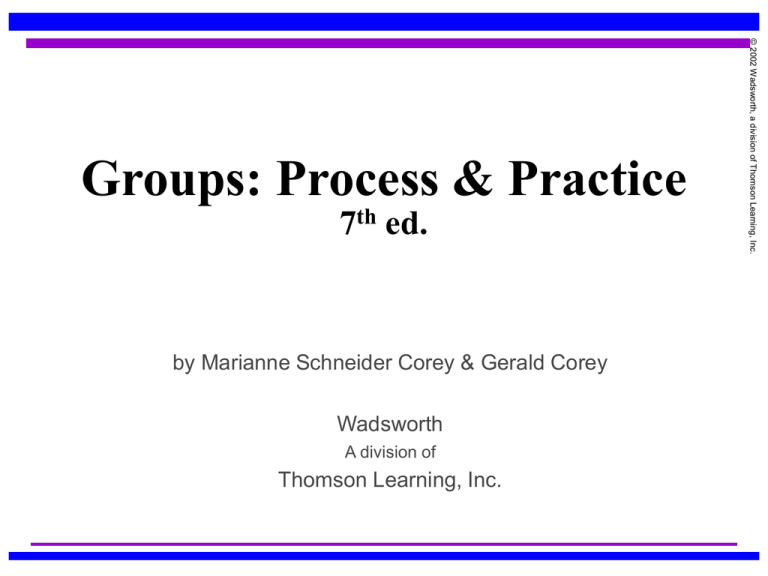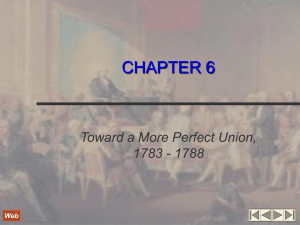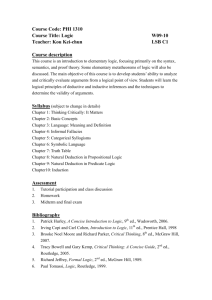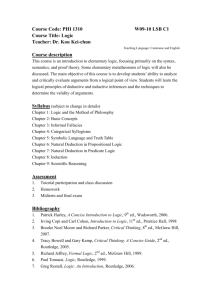Groups: Process and Practice- 6th ed.
advertisement

7th ed. by Marianne Schneider Corey & Gerald Corey Wadsworth A division of Thomson Learning, Inc. © 2002 Wadsworth, a division of Thomson Learning, Inc. Groups: Process & Practice The Corey’s Perspective on Groups Groups are not a second-rate approach to helping people change © 2002 Wadsworth, a division of Thomson Learning, Inc. Introduction to Group Work Groups are the treatment of choice Groups offer a natural laboratory where people can experiment with new ways of being Groups: Process & Practice - Chapter 1 (1) Transparency 2 There is power in a group – participants can experience their interpersonal difficulties being played out in the group Group process – all the elements that are basic to the unfolding of a group from beginning to end Examples: group norms, generating trust, how conflict emerges in a group, patterns of resistance, intermember feedback © 2002 Wadsworth, a division of Thomson Learning, Inc. Group Process Versus Group Techniques Group techniques – leader interventions aimed at facilitating movement within a group Groups: Process & Practice - Chapter 1 (2) Transparency 3 Examples: conducting initial interviews, asking a member to role-play a conflict, challenging a member’s belief system, suggesting homework An integrative conceptual framework involves the thinking, feeling, and behaving dimensions Creating an integrative approach is a challenge © 2002 Wadsworth, a division of Thomson Learning, Inc. The Theory Behind the Practice Technical eclecticism – based on utilizing techniques from a variety of theoretical models Groups: Process & Practice - Chapter 1 (3) Transparency 4 Theoretical integration – a conceptual creation beyond mere blending of techniques Task groups – aims to foster accomplishing identified work goals Psychoeducational group – aims to educate wellfunctioning group members who want to acquire information and skills in an area of living © 2002 Wadsworth, a division of Thomson Learning, Inc. Various Types of Groups Group counseling – aims at preventive and educational purposes — utilizes methods of interactive feedback within a here-and-now time framework Groups: Process & Practice - Chapter 1 (4) Transparency 5 Group psychotherapy – aims at remediation of in-depth psychological problems — often focuses on past influences of present difficulties Effective group work involves considering culture of participants Practitioners cannot afford to ignore diversity in group work © 2002 Wadsworth, a division of Thomson Learning, Inc. A Multicultural Perspective on Group Work Group workers must have awareness, knowledge, and skills to effectively deal with diverse membership Groups: Process & Practice - Chapter 1 (5) Transparency 6 Cultural similarities and differences need to be addressed in a group Some personal characteristics of effective group leaders Courage Presence Goodwill and caring Openness Becoming aware of your own culture Personal power Groups: Process & Practice - Chapter 2 (1) Transparency 7 Stamina Willingness to seek new experiences © 2002 Wadsworth, a division of Thomson Learning, Inc. The Group Counselor: Person and Professional Essential to acquire and refine skills applied to group work Group leadership skills cannot be separated from the leader’s personality © 2002 Wadsworth, a division of Thomson Learning, Inc. Group-Leadership Skills It is an art to learn how to use group skills Groups: Process & Practice - Chapter 2 (2) Transparency 8 Ways to learn leadership skills – supervised experience, practice, feedback, and experience in a group as a member Clarifying Modeling Linking Blocking Suggesting Summarizing Interpreting Terminating © 2002 Wadsworth, a division of Thomson Learning, Inc. A Few Group Leadership Skills Facilitating Transparency 9 Groups: Process & Practice - Chapter 2 (3) Diversity competence – involves a deep understanding of one’s own culture Culturally competent group workers need to: © 2002 Wadsworth, a division of Thomson Learning, Inc. Becoming a Diversity-Sensitive Group Counselor Be aware of their biases, stereotypes, and prejudices Know something about the members of the group Be able to apply skills and interventions that are congruent with the worldviews of the members Groups: Process & Practice - Chapter 2 (4) Transparency 10 Ethical practice entails diversity competence Group workers need to: Consider the impact of adverse environmental factors in assessing problems of group members © 2002 Wadsworth, a division of Thomson Learning, Inc. Guidelines for Competence: Diversity Issues in Groups Be aware of how their values and beliefs influence their facilitation of a group Respect the roles of family and community hierarchies within a member’s culture Acknowledge that ethnicity and culture influence behavior Groups: Process & Practice - Chapter 2 (5) Transparency 11 Respect members’ religious and spiritual beliefs and values Professional competence in group work is not a final product, but a continuous process for the duration of one’s career Some suggestions for increasing your level of competence as a group leader: © 2002 Wadsworth, a division of Thomson Learning, Inc. Best Practice Guidelines of ASGW (1998) Keep current through continuing education and participation in personal and professional development activities Be open to seeking personal counseling if you recognize problems that could impair your ability to facilitate a group Groups: Process & Practice - Chapter 3 (1) Transparency 12 Be willing to seek consultation and supervision as needed ASGW (2000) has recommendations for what constitutes competence as a group facilitator – Knowledge competencies: course work is essential © 2002 Wadsworth, a division of Thomson Learning, Inc. Professional Training Standards for Group Workers Skills competencies: specific group facilitation skills are required for effectively intervening Groups: Process & Practice - Chapter 3 (2) Transparency 13 Core specialization in group work: task facilitation groups; psychoeducational groups; counseling groups; psychotherapy groups Informed consent Provide members with adequate information that will allow them to decide if they want to join a group © 2002 Wadsworth, a division of Thomson Learning, Inc. Ethical and Legal Issues in Group Counseling Some information to give prospective members: The nature of the group The goals of the group The general structure of the sessions is expected of them if they join What they can expect from you as a leader Groups: Process & Practice - Chapter 3 (3) Transparency 14 What Many groups are composed of involuntary members The challenge is to demonstrate the value of a group for members © 2002 Wadsworth, a division of Thomson Learning, Inc. Involuntary Group Membership Basic information about the group is essential Avoid assuming that involuntary members will not want to change Transparency 15 Groups: Process & Practice - Chapter 3 (4) Although there are benefits to participating in a group, there are also potential risks that group leaders need to monitor — © 2002 Wadsworth, a division of Thomson Learning, Inc. Psychological Risks of Group Participation Members may be pressured to disclose and violate privacy Confidentiality may be broken Scapegoating may occur Group leaders may not have the competencies to deal with some difficulties that arise in a group Groups: Process & Practice - Chapter 3 (5) Transparency 16 Confrontation may be done in an uncaring manner © 2002 Wadsworth, a division of Thomson Learning, Inc. Confidentiality Confidentiality is the foundation of a working group Leaders need to define the parameters of confidentiality including its limitations in a group setting Members need to be taught what confidentiality involves Leaders talk to members about the consequences of breaching confidentiality Groups: Process & Practice - Chapter 3 (6) Transparency 17 Leaders remind members at various points in a group of the importance of maintaining confidentiality Groups: Process & Practice - Chapter 3 (7) Transparency 18 Your techniques should have a rationale Introduce techniques in a sensitive and timely manner Don’t stick to a technique if it is not working effectively Give members a choice – invite them to experiment with some behavior Use techniques that are appropriate to the member’s cultural values Techniques are best developed in response to what is happening in the here-and-now © 2002 Wadsworth, a division of Thomson Learning, Inc. Guidelines for Using Techniques Ethically Essential that you are aware of your values and how they influence what you think, say, and do in groups Groups are not a forum for you to impose your values on members © 2002 Wadsworth, a division of Thomson Learning, Inc. The Role of Group Leader Values Purpose of a group: to assist members in examining options that are most congruent with their values Groups: Process & Practice - Chapter 3 (8) Transparency 19 Group members have the task of clarifying their own values and goals, making informed choices, and assuming responsibility for what they do Take time and care in screening candidates for a group; and for preparing them on how to actively participate © 2002 Wadsworth, a division of Thomson Learning, Inc. Some Legal Safeguards for Group Practitioners Demystify the group process Strive to develop collaborative relationships with the members Incorporate ethical standards in the practice of group work Groups: Process & Practice - Chapter 3 (9) Transparency 20 Consult with colleagues or supervisors whenever there is a potential ethical or legal concern Five areas for a practical proposal for a group Rationale – What is the rationale for your group? Objectives – Are your objectives specific and attainable? © 2002 Wadsworth, a division of Thomson Learning, Inc. Forming a Group Practical considerations – Have you considered all the relevant practical issues in forming your group? Evaluation – How will you evaluate the process and outcomes of the group? Groups: Process & Practice - Chapter 4 (1) Transparency 21 Procedures – What kinds of techniques and interventions will you employ to attain the stated objectives? © 2002 Wadsworth, a division of Thomson Learning, Inc. Questions for Screening of Potential Members The type of group determines the kind of members that are suitable or unsuitable The key questions are Should this person be included in this group at this time with this leader? Other questions -What methods of screening will you use? How can you decide who may benefit from a group? How might you deal with a candidate who is not accepted to your group? Groups: Process & Practice - Chapter 4 (2) Transparency 22 And who might not fit in a group? Group composition Group size Open versus closed group © 2002 Wadsworth, a division of Thomson Learning, Inc. Practical Considerations in Forming a Group Length of the group Frequency and duration of meetings Place for group sessions Transparency 23 Groups: Process & Practice - Chapter 4 (3) Group setting offers support for new behavior and encourages experimentation The group is a microcosm of the real world – allows us to see how we relate to others © 2002 Wadsworth, a division of Thomson Learning, Inc. Some Advantages of a Group Group setting provides an optimal arena for members to discover how they are perceived and experienced by others Groups: Process & Practice - Chapter 4 (4) Transparency 24 Groups help members see that they are not alone in their concerns Groups are suited for everyone The main goal of a group is for everyone to achieve closeness © 2002 Wadsworth, a division of Thomson Learning, Inc. A Few Misconceptions About Groups Groups tell people how they should be Group pressure forces members to lose their sense of identity Groups: Process & Practice - Chapter 4 (5) Transparency 25 Groups are artificial and unreal Characteristics of initial stage Participants test the atmosphere and get acquainted Risk taking is relatively low – exploration is tentative © 2002 Wadsworth, a division of Thomson Learning, Inc. Initial Stage of a Group Members are concerned with whether they are included or excluded A central issue is trust versus mistrust There are periods of silence and awkwardness Groups: Process & Practice - Chapter 5 (1) Transparency 26 Members are deciding how much they will disclose and how safe the group is Anxiety over being accepted or rejected Concern about the judgment of others Afraid of appearing stupid © 2002 Wadsworth, a division of Thomson Learning, Inc. Common Fears Experienced by Group Members Concerns about not fitting into the group Not knowing what is expected Groups: Process & Practice - Chapter 5 (2) Transparency 27 Concern over communicating feelings and thoughts effectively Dealing with the here-and-now energizes the group Members are best known by disclosing here-and-now experiencing © 2002 Wadsworth, a division of Thomson Learning, Inc. Advantages of Developing a Here-And-Now Focus Being in the here-and-now serves as a springboard for exploring everyday life concerns Transparency 28 Groups: Process & Practice - Chapter 5 (3) Careful attending and genuine listening Empathy Genuineness and self-disclosure © 2002 Wadsworth, a division of Thomson Learning, Inc. Leader Attitudes and Behaviors That Generate Trust Respect Caring confrontation Transparency 29 Groups: Process & Practice - Chapter 5 (4) Main task – helping members formulate clear and specific goals Absence of goals – considerable floundering and aimless sessions © 2002 Wadsworth, a division of Thomson Learning, Inc. Establishing Goals Collaborative process in identifying goals Groups: Process & Practice - Chapter 5 (5) Transparency 30 Goals – lead to contracts and homework assignments Norms and procedures enable a group to attain its goals Examples of group norms – Expectation of promptness and regular attendance © 2002 Wadsworth, a division of Thomson Learning, Inc. Group Norms Norm of sharing oneself in personal ways Expectation of giving meaningful feedback Members encouraged to offer both support and challenge to others Groups: Process & Practice - Chapter 5 (6) Transparency 31 Members functioning within the here-and-now context of the group Express persistent reactions Come prepared to group sessions Decide for yourself what and how much to disclose © 2002 Wadsworth, a division of Thomson Learning, Inc. Member Guidelines to Benefit from a Group Be an active participant Be open to feedback and consider what you hear Experiment with new behavior in group Transparency 32 Groups: Process & Practice - Chapter 5 (7) Division of responsibility – How to achieve a balance of sharing responsibility with members? Degree of structuring – Creating a structure that will enable members to make maximum use of group process © 2002 Wadsworth, a division of Thomson Learning, Inc. Group Leader Issues at the Initial Stage Opening group sessions – How to best open a group and help members gain a focus? Groups: Process & Practice - Chapter 5 (8) Transparency 33 Closing group sessions – How to best bring a session to closure without closing down further work later on? Characteristics of the transition stage Transitional phase is marked by feelings of anxiety and defenses Members are: testing Groups: Process & Practice - Chapter 6 (1) Transparency 34 the leader and other members to determine how safe the environment is struggling between wanting to play it safe and wanting to risk getting involved observing the leader to determine if he or she is trustworthy learning how to express themselves so that others will listen © 2002 Wadsworth, a division of Thomson Learning, Inc. Transition Stage of a Group Some signs of a low level of trust Members are: Hesitant in expressing what they are thinking and feeling © 2002 Wadsworth, a division of Thomson Learning, Inc. Barometer of Trust in a Group Unwilling to initiate personally meaningful work Denying that they have any problems or concerns Not willing to deal with conflict in the group Groups: Process & Practice - Chapter 6 (2) Transparency 35 Hiding behind global statements and intellectualizations Don’t label all hesitations as a sign of resistance Respect resistance – Realize that member resistance may be serving a function © 2002 Wadsworth, a division of Thomson Learning, Inc. Thoughts on Dealing with Resistance Therapeutically Invite members to explore the meaning of what appears to be resistance Describe behavior of members – avoid making too many interpretations Groups: Process & Practice - Chapter 6 (3) Transparency 36 Approach resistance with interest, understanding, and compassion Fear of making a fool of oneself Fear of emptiness Fear of losing control © 2002 Wadsworth, a division of Thomson Learning, Inc. Common Fears Emerging at the Transition Stage Fear of being too emotional Fear of self-disclosure Fear of taking too much of the group’s time Groups: Process & Practice - Chapter 6 (4) Transparency 37 Fear of being judged If you confront, know why you are confronting Confront if you care about the other In confronting another – talk more about yourself than the other person © 2002 Wadsworth, a division of Thomson Learning, Inc. Some Guidelines for Effective Confrontation Avoid dogmatic statements and judgments about the other Groups: Process & Practice - Chapter 6 (5) Transparency 38 Give others the space to reflect on what you say to them Avoid responding with sarcasm State your observations and hunches in a tentative way © 2002 Wadsworth, a division of Thomson Learning, Inc. Group Leader Interventions in Dealing with Difficult Behaviors of Group Members Demonstrate sensitivity to a member’s culture Avoid taking member’s behavior in an overly personal way Groups: Process & Practice - Chapter 6 (6) Transparency 39 Encourage members to explore a resistance – don’t demand they give up a particular “resistive” behavior Silence Monopolistic behavior Storytelling © 2002 Wadsworth, a division of Thomson Learning, Inc. Examples of Problematic Styles of Behaving in a Group Giving advice Questioning Dependency Groups: Process & Practice - Chapter 6 (7) Transparency 40 Intellectualizing Show members the value of recognizing and dealing fully with conflict situations Help members to recognize their own patterns of defensiveness © 2002 Wadsworth, a division of Thomson Learning, Inc. Leader Functions During the Transition Stage Teach members to respect resistance and to work constructively with the many forms it takes Encourage members to express reactions that pertain to here-and-now happenings in the sessions Groups: Process & Practice - Chapter 6 (8) Transparency 41 Provide a model for members by dealing directly and tactfully with any challenge © 2002 Wadsworth, a division of Thomson Learning, Inc. Working Stage of a Group Key points of the working stage There are no arbitrary dividing lines between each stage of group Group development ebbs and flows – does not stay static Work can occur at every stage – not just the working stage Not all groups reach a working stage Groups: Process & Practice - Chapter 7 (1) Transparency 42 Not all members are functioning at the same level in a working stage At the working stage of a group there is further development and solidification of group norms established earlier © 2002 Wadsworth, a division of Thomson Learning, Inc. Group Norms and Behavior at the Working Stage Some group behaviors at the working stage Both support and challenge to take risks in group Leader uses a variety of therapeutic interventions Members interact with each other in more direct ways Increased group cohesion fosters action-oriented behaviors Groups: Process & Practice - Chapter 7 (2) Transparency 43 Healing capacity develops within the group There is a focus on the here and now Goals of members are clear and specific Cohesion is high – a sense of emotional bonding in the group © 2002 Wadsworth, a division of Thomson Learning, Inc. Characteristics of a Productive Group Conflict in the group is recognized and explored Members are willing to make themselves known Groups: Process & Practice - Chapter 7 (3) Transparency 44 Trust is increased and there is a sense of safety Mistrust is manifested by an undercurrent of unexpressed feelings Participants focus more on others than themselves © 2002 Wadsworth, a division of Thomson Learning, Inc. Characteristics of a Nonworking Group Participants hold back – disclosure is minimal Members may feel distant from one another Conflicts are ignored or avoided Groups: Process & Practice - Chapter 7 (4) Transparency 45 Communication is unclear and indirect Disclosure versus anonymity Honesty versus superficiality Spontaneity versus control © 2002 Wadsworth, a division of Thomson Learning, Inc. Choices to be Made During the Working Stage Acceptance versus rejection Cohesion versus fragmentation Transparency 46 Groups: Process & Practice - Chapter 7 (5) Group: not an end in itself Group is: A place to learn new behaviors A place to acquire a range of skills in living Training ground for everyday life Groups: Process & Practice - Chapter 7 (6) Transparency 47 Homework – a means for maximizing what is learned in group Members can devise their own homework assignments Ideally, homework is designed collaboratively between members and leader © 2002 Wadsworth, a division of Thomson Learning, Inc. The Value of Homework in Groups Self-Disclosure Caring and Acceptance Confrontation Power Feedback Catharsis Cohesion and Universality The Cognitive Component Hope Commitment to Change Willingness to Risk and Trust Freedom to Experiment Transparency 48 Groups: Process & Practice - Chapter 7 (7) Humor © 2002 Wadsworth, a division of Thomson Learning, Inc. Therapeutic Factors Operating in Groups Disclosure – related to the purposes of the group Persistent reactions – useful to express persistent thoughts and feelings © 2002 Wadsworth, a division of Thomson Learning, Inc. Guidelines for Member Self-Disclosure Members decide what and how much to disclose Safe climate – disclosure increases in a safe group Groups: Process & Practice - Chapter 7 (8) Transparency 49 Level of disclosure – stage of group may determine what is appropriate Give feedback with honesty and with sensitivity Concise feedback given in a clear and straightforward way is useful © 2002 Wadsworth, a division of Thomson Learning, Inc. Guidelines for Giving Feedback In giving feedback, let others know how their behavior affects you Avoid giving global feedback Groups: Process & Practice - Chapter 7 (9) Transparency 50 Avoid being judgmental in giving feedback Catharsis – the expression of pent-up emotions Catharsis can be healing and can lead to increased cohesion © 2002 Wadsworth, a division of Thomson Learning, Inc. Catharsis in Groups Catharsis is not appropriate for all types of groups After a catharsis – It is useful to integrate cognitive and behavioral work It is crucial to put insights into action Groups: Process & Practice - Chapter 7 (10) Transparency 51 Insights are common Tasks of the final stage of a group: Dealing with feelings of separation Dealing with unfinished business © 2002 Wadsworth, a division of Thomson Learning, Inc. Ending a Group Reviewing the group experience Practice for behavioral change Giving and receiving feedback The use of a contract and homework Groups: Process & Practice - Chapter 8 (1) Transparency 52 Ways of carrying learning further Assist members in dealing with any feelings they might have about termination Reinforce changes that members have made during the group © 2002 Wadsworth, a division of Thomson Learning, Inc. Leader Functions During Ending Phase of Group Work with members to develop specific contracts and homework assignments Reemphasize the importance of maintaining confidentiality after the group is over Groups: Process & Practice - Chapter 8 (2) Transparency 53 Provide opportunities for members to give one another constructive feedback Offer private consultations if any member should need this service Provide for a follow-up group session or follow-up individual interviews © 2002 Wadsworth, a division of Thomson Learning, Inc. Leader Functions After Termination of a Group Identify referral sources for members who may need further assistance Groups: Process & Practice - Chapter 8 (3) Transparency 54 Evaluate the strengths and weaknesses of the group The sentence completion method can enhance the quality of feedback and can result in focused feedback Examples: © 2002 Wadsworth, a division of Thomson Learning, Inc. Giving and Receiving Feedback at the Ending Stage Groups: Process & Practice - Chapter 8 (4) Transparency 55 My greatest fear for you is ... My hope for you is... I hope that you will seriously consider... I see you blocking your strengths by... Some things I hope you will think about doing for yourself are... Some ways I hope you’d be different with others are... Members can be reminded of ways to translate what was learned in group and assisted in developing action plans geared to change © 2002 Wadsworth, a division of Thomson Learning, Inc. Applying What is Learned in Group to Everyday Life Some points: A group is a means to an end Change is bound to be slow and subtle Decide what you will do with what you learned about yourself Groups: Process & Practice - Chapter 8 (5) Transparency 56 Focus more on changing yourself than on changing others Developing a proposal: Groups for children In planning groups for children: Describe your goals and purposes clearly © 2002 Wadsworth, a division of Thomson Learning, Inc. Groups for Children Develop a clearly stated rationale for your proposed group Groups: Process & Practice - Chapter 9 (1) Transparency 57 State your aims, the procedures to be used, the evaluation procedures you will use, and the reasons a group approach has particular merit Be aware of your state’s laws regarding children Consider securing parental or guardian written permission © 2002 Wadsworth, a division of Thomson Learning, Inc. Guidelines for Group Work with Children and Adolescents Communicate your expectations to those in your group Emphasize confidentiality Maintain neutrality Use appropriate exercises and techniques Prepare for termination Groups: Process & Practice - Chapter 9 (2) Transparency 58 Listen and remain open In designing a group in both schools and agencies, get the support of administrators Communicate with children about the importance of keeping confidences in language they can grasp © 2002 Wadsworth, a division of Thomson Learning, Inc. Key Points – Groups for Children Ethical practice demands that you have the training required to facilitate a group with children Not all children are ready for group participation Give thought to helpful methods of evaluating the outcomes of your groups Groups: Process & Practice - Chapter 9 (3) Transparency 59 Having some structure is particularly important in groups with children Organizing an adolescent group Conduct a needs assessment Develop a written proposal © 2002 Wadsworth, a division of Thomson Learning, Inc. Groups for Adolescents Market your group Get informed consent from parents or guardians Conduct pregroup interviews Select members for the group Arrange for a follow-up group session after termination Groups: Process & Practice - Chapter 10 (1) Transparency 60 Design a plan for each of the group sessions Explain the rationale of the group in jargon-free language Allow members to express reactions to being sent to group © 2002 Wadsworth, a division of Thomson Learning, Inc. Hints – Working with Reluctant Adolescent Group Members Go with resistance – Don’t go against resistance Avoid getting defensive Groups: Process & Practice - Chapter 10 (2) Transparency 61 Be clear and firm with your boundaries Philosophy of group and overall goals Overview of group Group format – weekly sessions © 2002 Wadsworth, a division of Thomson Learning, Inc. Sample Group Proposal – Multiple Family Group Therapy Practical considerations Contraindications to participation in group Outcomes of group Transparency 62 Groups: Process & Practice - Chapter 10 (3) © 2002 Wadsworth, a division of Thomson Learning, Inc. Key Points – Groups for Adolescents Understand and respect resistance Role-playing techniques can often be creatively used in adolescent groups Find ways to involve parents in group work with adolescents Co-leadership models are especially useful in facilitating an adolescent group Groups: Process & Practice - Chapter 10 (4) Transparency 63 A few kinds of adolescent groups include: groups for students on drug rehabilitation, groups for unwed teenage fathers, teen delinquency prevention groups, and sex offender treatment groups Theme-oriented groups with a psychoeducational focus are popular Short-term and structured groups fit the needs of many adult populations © 2002 Wadsworth, a division of Thomson Learning, Inc. Key Points – Groups for Adults Account for diversity in your groups Group work with women is increasing Groups dealing with domestic violence are gaining prominence Groups: Process & Practice - Chapter 11 (1) Transparency 64 Most men’s groups have a psychoeducational and interpersonal focus Groups for college students Groups for weight control HIV/AIDS support group © 2002 Wadsworth, a division of Thomson Learning, Inc. Examples of Groups for Adults Women’s group Men’s group Domestic violence group Groups: Process & Practice - Chapter 11 (2) Transparency 65 Support group for survivors of incest In designing a specific group, consider these components Description of the type of your group © 2002 Wadsworth, a division of Thomson Learning, Inc. Sample Proposal for a Group with Adults Rationale of your group Goals of your group Marketing methods Screening and selection members Methods for assessing outcomes Groups: Process & Practice - Chapter 11 (3) Transparency 66 Structure of group – description of sessions You may encounter obstacles in your attempts to organize and conduct groups for the elderly Groups offer unique advantages for the elderly who have a great need to be listened to and understood © 2002 Wadsworth, a division of Thomson Learning, Inc. Key Points – Groups for the Elderly Groups can help elderly people integrate current life changes into an overall developmental perspective Elderly people need a clear explanation of the group’s purposes – and why they can benefit from it Groups: Process & Practice - Chapter 12 (1) Transparency 67 Revealing personal matters may be extremely difficult for some elderly people because of their cultural conditioning Themes that are prevalent with the elderly include: Loss and the struggle to find meaning in life Loneliness and social isolation Poverty Feelings of rejection Dependency Feelings of uselessness, hopelessness, and despair Fears of death and dying Grief over others’ deaths Sadness over physical and mental deterioration Regrets over past events Groups: Process & Practice - Chapter 12 (2) Transparency 68 © 2002 Wadsworth, a division of Thomson Learning, Inc. Themes in Working with Elderly Populations Some groups that are commonly offered include those with an emphasis on Reminiscing Physical fitness Body awareness Grief work Occupational therapy Music and art therapy Groups: Process & Practice - Chapter 12 (3) Preretirement and postretirement issues Remotivation Organic brain syndrome Health-related issues Transparency 69 Reality orientation Combined dance and movement © 2002 Wadsworth, a division of Thomson Learning, Inc. Examples of Groups for the Elderly





